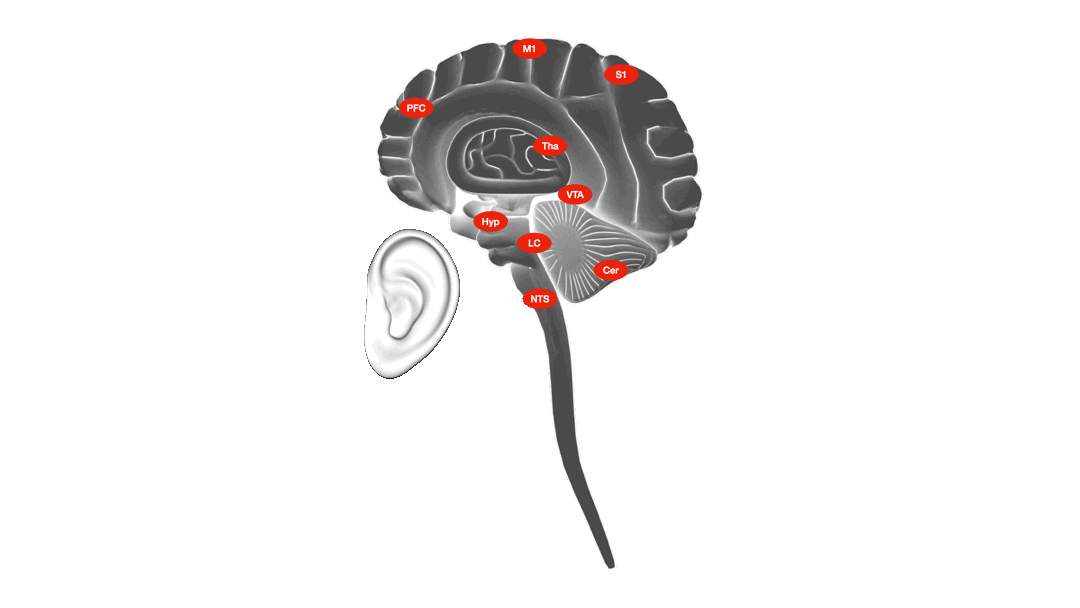ETH Zurich researchers have developed a smart earpiece that helps people relearn physical actions faster and more easily after a stroke. By stimulating the brain, the earpiece helps it rewire neural circuits.
Strokes are the number one cause of persistent physical impairment among adults worldwide. Sufferers often find it hard or even impossible to perform everyday physical actions like walking or reaching for something. One reason for this is that the stroke has damaged regions in the brain involved in making the necessary movements.
Initial clinical studies conducted by other scientists have shown that stimulating the vagus nerve plays a crucial role in rehabilitating regions of the brain damaged by a stroke. Such stimulation has allowed stroke patients to regain their movement faster and more effectively.

Earpiece for speeding up the recovery after stroke. Image credit: ETH Zurich (still frame from the video)
But until now, this has required patients to undergo an expensive operation, performed under general anaesthetic, to implant a stimulation device below the skin. Since it’s common practice to wait a full year after a stroke to carry out this procedure, patients are losing valuable time.
Now, ETH researchers Paulius Viskaitis and Dane Donegan from the Rehabilitation Engineering Laboratory have developed a new system that is set to make vagus nerve stimulation much easier and available much faster: “Our earpiece emits subtle electrical impulses to activate the nerve in the outer ear, thus eliminating the need for a surgical procedure,” explains Viskaitis, who was recently awarded an ETH Zurich Pioneer Fellowship to help him bring the technology to market.

Since nerve cells communicate through changes in the flow of electricity, an electrical impulse to the ear can trigger a neural signal that travels up the vagus nerve to the brain. Image credit: Donegan and Viskaitis / ETH Zurich
Electrical impulses help the brain learn
A few years ago while still at the University of Colorado, Donegan was able to show that stimulating the vagus nerve wasn’t the only factor. The neuroscientist demonstrated that timing is also critical: the electrical impulses are particularly effective if administered while patients are attempting those motions that they have found difficult to perform since their stroke.
This helps the brain rewire motor neural circuits to compensate for malfunctions in regions damaged by the stroke. “It’s like we’re reconfiguring the brain’s software: stimulating the nerve promotes neuroplasticity, aids the formation of new synapses and supports the relearning of physical actions,” Donegan says.

Pioneer Fellow Paulius Viskaitis (left) and Dane Donegan have developed a new rehabilitation system for stroke patients. Image credit: ETH Zurich / Stefan Schneller)
Movement sensor enables targeted stimulation
Another disadvantage of the implanted sensor treatment is that afterwards a physical therapist must be on hand to manually operate the stimulator. This eats up a lot of time and money.
So what the two ETH researchers have done is develop a movement sensor that works a bit like a smartwatch. Stroke patients wear this sensor wherever their motor function is impaired, for instance on their right arm. Using special software, which Viskaitis and Donegan also developed, the sensor analyses the arm’s movements in real time and tells the earpiece when the patient moved their arm particularly well.
This triggers stimulation of the vagus nerve and the brain learns to recall the correct sequence of movements faster and more effectively. The technical term for this process is reinforcement learning.
Home treatment possible
Unlike previous treatment options, stroke patients can use the technology developed by the two ETH researchers also without professional supervision. What’s more, the movement sensor will make it possible for physical therapists to monitor their patients’ progress conveniently using a smartphone. The ETH researchers expect this to yield further progress in treatment.
By the end of this summer, Viskaitis and Donegan want to launch an ETH spin-off and move ahead with tests on healthy people as quickly as possible. They plan to then proceed with the first clinical study.
Source: ETH Zurich
